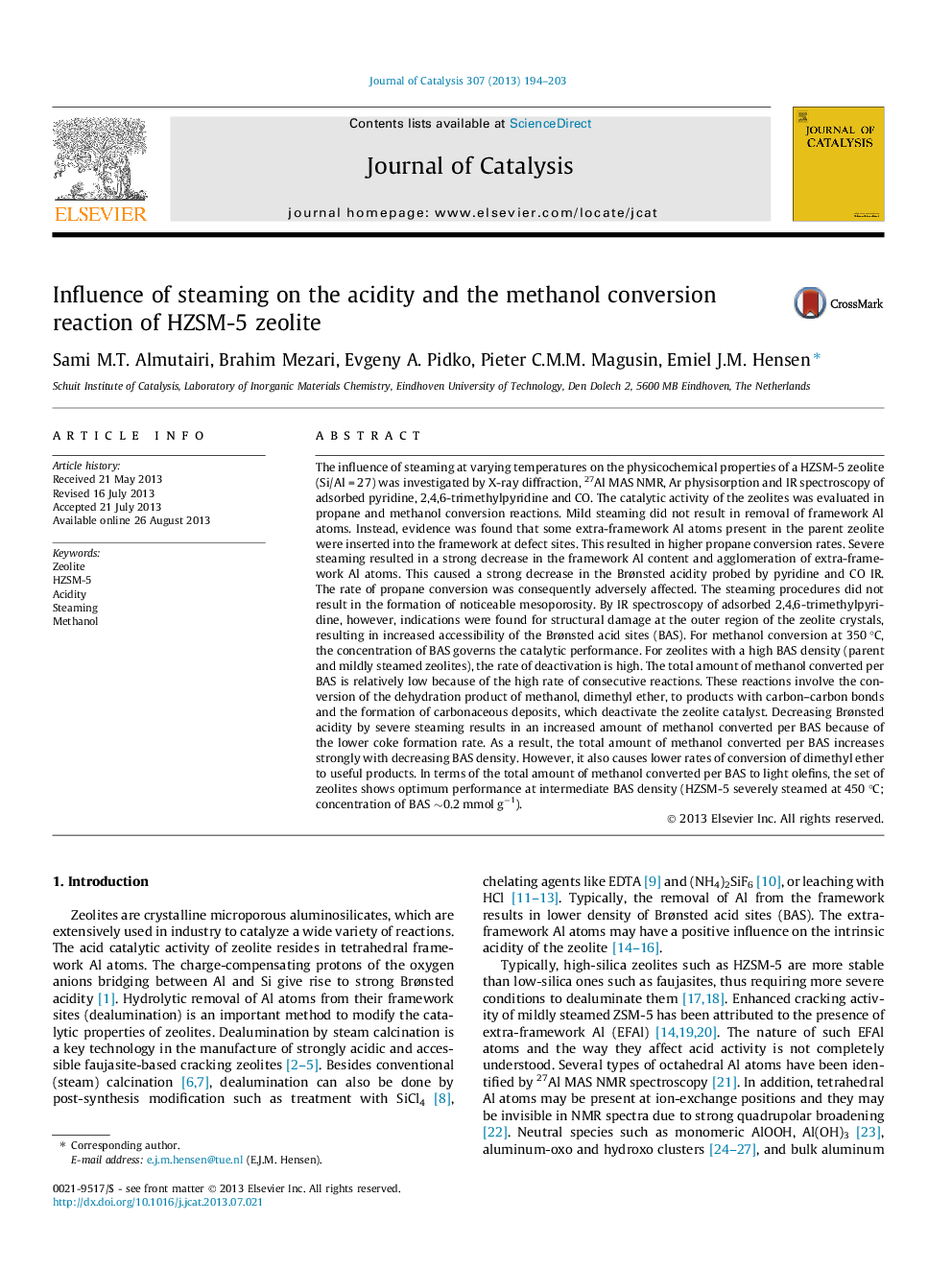| کد مقاله | کد نشریه | سال انتشار | مقاله انگلیسی | نسخه تمام متن |
|---|---|---|---|---|
| 61162 | 47567 | 2013 | 10 صفحه PDF | دانلود رایگان |

• HZSM-5 zeolite treated at varying steam flows and temperatures.
• Porosity hardly affected by steam treatment.
• Insertion of Al into framework at low steam flow.
• Significant framework Al removal at high steam flow.
• Intermediate Brønsted acidity optimal for methanol conversion reaction.
The influence of steaming at varying temperatures on the physicochemical properties of a HZSM-5 zeolite (Si/Al = 27) was investigated by X-ray diffraction, 27Al MAS NMR, Ar physisorption and IR spectroscopy of adsorbed pyridine, 2,4,6-trimethylpyridine and CO. The catalytic activity of the zeolites was evaluated in propane and methanol conversion reactions. Mild steaming did not result in removal of framework Al atoms. Instead, evidence was found that some extra-framework Al atoms present in the parent zeolite were inserted into the framework at defect sites. This resulted in higher propane conversion rates. Severe steaming resulted in a strong decrease in the framework Al content and agglomeration of extra-framework Al atoms. This caused a strong decrease in the Brønsted acidity probed by pyridine and CO IR. The rate of propane conversion was consequently adversely affected. The steaming procedures did not result in the formation of noticeable mesoporosity. By IR spectroscopy of adsorbed 2,4,6-trimethylpyridine, however, indications were found for structural damage at the outer region of the zeolite crystals, resulting in increased accessibility of the Brønsted acid sites (BAS). For methanol conversion at 350 °C, the concentration of BAS governs the catalytic performance. For zeolites with a high BAS density (parent and mildly steamed zeolites), the rate of deactivation is high. The total amount of methanol converted per BAS is relatively low because of the high rate of consecutive reactions. These reactions involve the conversion of the dehydration product of methanol, dimethyl ether, to products with carbon–carbon bonds and the formation of carbonaceous deposits, which deactivate the zeolite catalyst. Decreasing Brønsted acidity by severe steaming results in an increased amount of methanol converted per BAS because of the lower coke formation rate. As a result, the total amount of methanol converted per BAS increases strongly with decreasing BAS density. However, it also causes lower rates of conversion of dimethyl ether to useful products. In terms of the total amount of methanol converted per BAS to light olefins, the set of zeolites shows optimum performance at intermediate BAS density (HZSM-5 severely steamed at 450 °C; concentration of BAS ∼0.2 mmol g−1).
Whereas mild steam hardly affects Brønsted acidity of HZSM-5, severe steaming results in significant removal of framework Al tuning Brønsted acidity for optimum performance in methanol conversion. Too high acidity results in a low turnover number of methanol per acid site; too low acidity predominantly in predominant formation of dimethylether. Steaming does not result in noticeable mesoporosity in the zeolite crystals.Figure optionsDownload high-quality image (201 K)Download as PowerPoint slide
Journal: Journal of Catalysis - Volume 307, November 2013, Pages 194–203